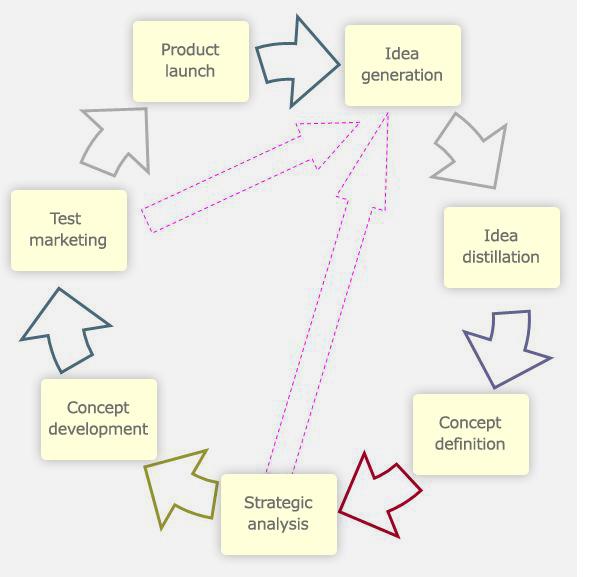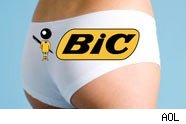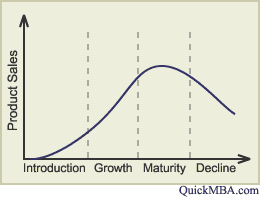
MARK 5320: Advanced Marketing Fundamentals
Chapter 7: Developing and Managing Offerings
This module reviews what is involved in developing new offerings and how those offerings can be managed effectively. The new offering development process is discussed in detail, from idea generation through evaluation. Then, the product life cycle and strategies for maximizing profits at each stage are covered.
The process for creating offerings and bringing them to market is discussed.

Sources of ideas:
Individuals who got an idea for a product and then tried to make and sell it. Customers in Business-to-Business markets are probably the biggest source of new product ideas. Lead users generate new product ideas or applications. Customers are particularly important co-creators of offerings when they are consuming products with service components.
Suppliers might develop a new product or technology that can be used to make yet another product, and then go to the makers of those products and suggest new versions to them.
Competitors may have offerings protected by copyright or patents, but companies can develop products that serve the same purpose. Line extension occurs when a company comes out with another model (related product) based on the same platform and brand as one of its other products. Employees are another source. Idea Generation is generally the least expensive step in the development process.
Purpose of idea screening is to try to avoid new product mistakes early in the development process. It is expensive to develop a new product offering and the sooner bad ideas are discarded, the less the investment made and lost.
Bic has built its brand on the convenience of disposable products. Disposable razors? Disposable lighters? Convenient and affordable. Disposable underwear? Just plain weird. Other than the disposability factor, consumers could not find a link between the underwear and Bic's other products. With out a unifying factor, people were just confused. In addition, the idea of buying intimate attire from a company that also produces pens apparently does not appeal to most women

Quality Function Deployment (QFD) - process of looking at what benefits/features customers want in the new offering and then designing an offering that delivers those benefit/features. Question is whether to offer versions of the product at different price points.
In the development stage, the actual offering is designed, specifications for it are written, and prototypes are developed. Often companies will choose to develop products that are based on the same technology platform as existing products the company already makes.
Product is first tested in the lab, known as alpha testing, to make sure it meets the specifications demanded by customers. Product is then tested by real consumers, known as beta testing. This step can be expensive, so many companies choose to do a limited launch of a product instead and let the market respond through purchases. B2B beta tests are done with lead users and preferred customers, but there should be a strong relationship between customer and company because there may still be "bugs" that need to be worked out with the product. Along with product testing, the company may also be testing the marketing communication plan that will be used to launch the product.
Some companies choose to do a rolling launch, releasing the offering in a limited market to further test the waters. Others release the offering to all their markets.
Market tests are sometimes done to evaluate competing marketing plans. For example, one beverage maker tested the marketing plan for a new wine cooler by promoting the product as a "Polynesian" drink on the West coast and an "Australian" drink on the East coast. The Polynesian version proved more popular, so that is how the beverage of ultimately advertised and packaged.
Commercialization
This section discusses how organizations manage offerings after they are introduced to the marketplace. The four stages of the product lifecycle are identified and strategies for managing offerings at each stage are also explained. Once offerings are introduced in the marketplace, the offering has to be managed effectively in order for the customer to receive value from it. The management of a new offering becomes even more complex when a company decides to introduce the product in the global marketplace. Product lifecycle includes the stages a product goes through from introduction to extinction of the product. Understanding the stages of an offering's lifecycle enables a company better manage the offering and maximize profits. It should be noted that not all products go through all the stages and the length of each stage can vary considerably.

Also known as the commercialization stage or the last stage of the new product development process. Marketing costs highest in this stage with profits usually the lowest. Length of stage varies, but in U.S. a company is only allowed to use the label "new" on a product's packaging for six months. Specific promotional strategies depend on the type of product and the competition. Personal selling is useful in establishing distribution outlets to get the product to customers. Product pricing strategies depend on type of product, competition, distinguishing value provided to consumers versus existing products and the costs of developing the product.
Two major pricing strategies include:
New Pet
Characterized by increasing sales, more competitors and higher profits. Promotional spending may increase with a focus on promoting the specific benefits of the product and how it compares to the competition. Number of distribution outlets may also increase during the growth stage as more consumers demand access to the offering.
Sales begin to level off in this stage, with number of potential new customers declining and more competitors entering the market. Most products in the marketplace are in the maturity stage; buyers are repeat customers rather than new customers. This stage usually lasts the longest of the four stages. Companies are challenged to develop strategies to extend the maturity stage of their products so they can remain competitive.
Some strategies include:
Sales decrease and continue to drop. Some products go through decline faster than others. Fads are an example of rapid decline offerings.
Company has to decide whether to harvest or divest offering:
Kellogg's
The video is from Britain so you will see the pound symbol and not the dollar sign.